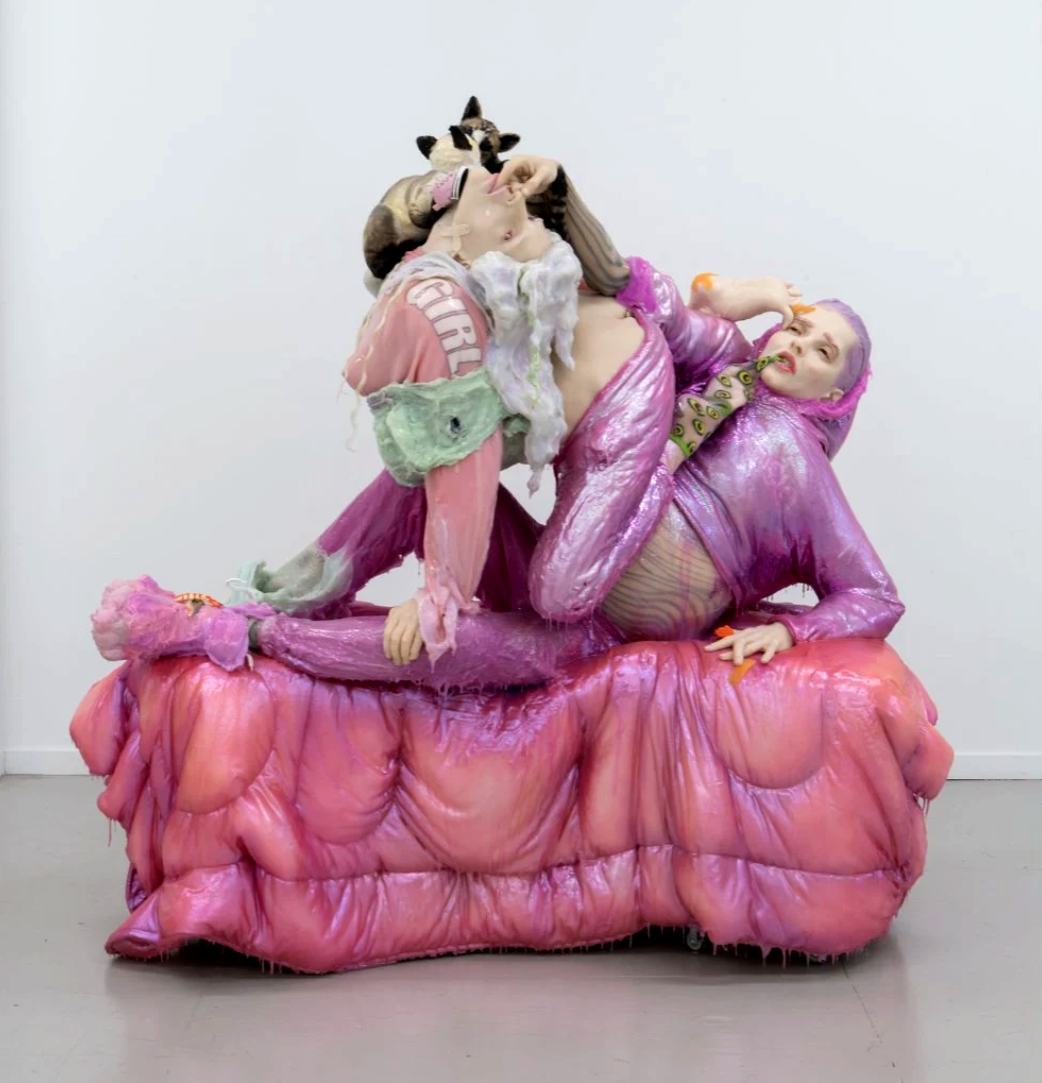Cajsa von Zeipel
Four Cats
, 2019Cajsa von Zeipel’s art explores themes like gender, identity, and queerness while questioning ideals of classicism through sculpture. Culling from sci-fi and fantasy aesthetics, she constructs her figures in brightly coloured silicone and adorns them with dollar store accoutrements turned glistening treasure. In a resolute assertion of femme visibility and sex-positive provocation, these beings unashamedly celebrate an empowered world of their own creation.
Four Cats, executed in 2019, is a typical example of Zeipel’s powerful sculptural expression. When Zeipel exhibited similar pieces at Andréhn-Schiptjenko in Stockholm (Cajsa von Zeipel - Futuristic Lesbian, 3 October-9 November 2019), the gallery gave the following introduction to Zeipel’s 2019 silicone sculptures:
Her show at the gallery in Stockholm is entitled Futuristic Lesbian and will encompass large, twisted, silicone sculptures full of found objects, pins, glitter and junk. Cajsa von Zeipel’s technical prowess is evident in these extraterrestrial sculptures. She has left the reference to classical sculpture and developed an even more complex technique. As opposed to her earlier tall, white sculptures in plaster and jesmonite the new ones are messy and almost grotesque. They seem to float beyond their human boundaries becoming futuristic bodies merging the human body with all kinds of stuff becoming a new kind of species.
Andria Nyberg Forshage (Swedish writer, independent curator, and poet whose transdisciplinary artistic research concerns queer- and transfeminist aesthetics, perception, desire, and survival) expanded and elaborated on the theme further in her text, The Permanent and Continual Distortion of All Bodies, which accompanied the exhibition:
Looking at Cajsa von Zeipel’s work, sculpted in glass fibre and molded in silicone, the soft surfaces and bodies are where found objects cling to each other: pins, glass bongs, accessories, more-than-human others, dogs and handbags, as bodies cling to clothes and mannequins to life; as parts of the body no less than its organs and limbs. Bodies that become sticky environments, collecting the detritus of street markets, street protests and street fashion. The object of art and the object of exchange – these are readymade statements, commodities sticking to and leaking toxins into any body ambulating through late capitalism, the spirits of clumping together, attaching value, status, form and meaning to bodies at once indifferent and ecstatic. Make America Gay Again, Tate, Super Pussy, Resist, what do you mean? Or rather, they seem to have assembled all at once, in a plastic flash, freezing and melting at the end of the world. Eyes open, contorting, welcoming life/death at last. Queerness is a harbinger of this end, as modern boundaries of naturecultures break down along with our ecosystems and economies. The future is at once here, now, and endlessly deferred, degrading more the more we get attached to it.
Zeipel’s silicone sculptures, anything but minimalistic in their almost baroque exuberance, have been described as existing in a microcosm of their own characterised by a palpable tension between seductive desire and the outright grotesque. In the same year as Four Cats was created, Zeipel elaborated on her work method (TANK Magazine, 2019):
I love it, especially the references that silicone carries: the playfulness of sex toys, its use in silicone breasts, and other medical equipment. It’s also a material that makes space for other materials – finally I can dig into my collection of fabric, glitter and Canal Street junk. It’s soft, it can move, it has a long life, like an avatar, I’m a big fan. […] I have always sculpted from a narrative. To create some sort of mindset for the sculptures is what I love to do. Sometimes I create the narrative with a group, sometimes in a gesture, sometimes in the gaze. […] I always work in this thin space between desire, seduction and the societal understanding of the grotesque – like someone vomiting or someone hating, or sex play. […] I don’t personally feel that they are grotesque in any way, but I like that people have to think about the expectations of perfection versus defect. People have expressed the urge to touch the sculptures or eat them, and this seductive pull and the physical reaction it creates make the viewer uncomfortable at times, which is that thin space I like to work in and put out into the world.
When Four Cats was included in the group exhibition As Dreamers Do at Bohuslän Museum, Uddevalla, Sweden (1 June-3 November 2024), art critic Oscar Svanelid, PhD (Sweden, born 1986), described Zeipel’s sculptures as ‘spectacular and sex positive’ and wrote the following in his review (in ‘Recension: As Dreamers Do på Bohusläns museum’, Göteborgs-Posten, 2 June 2024):
In the gallery’s small hall, there is a sensational interaction between Linnea Sjöberg’s strong, poetic tapestries and Cajsa von Zeipel’s grotesque silicone sculpture ‘Four Cats’. It’s not often that art turns me on, but you have to be pretty frigid to resist the sculpture’s queer, animal sexiness.
Provenance
Company Gallery, New York, Art Basel Miami Beach, Miami, Florida, U.S.A., 5-8 December 2019.
CFHILL, Stockholm, New York is for Lovers. Curated by Sophie Mörner, 11 May-12 August 2023.
Firestorm Foundation (acquired at the above).
Exhibitions
Bohuslän Museum, Uddevalla, Sweden, As Dreamers Do, 1 June-3 November 2024.
Copyright Firestorm Foundation
